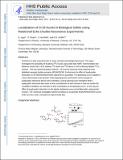| dc.contributor.author | Iuga, D. | |
| dc.contributor.author | Rossi, P. | |
| dc.contributor.author | Herzfeld, J. | |
| dc.contributor.author | Griffin, Robert Guy | |
| dc.date.accessioned | 2020-06-17T14:46:15Z | |
| dc.date.available | 2020-06-17T14:46:15Z | |
| dc.date.issued | 2017-04 | |
| dc.date.submitted | 2016-12 | |
| dc.identifier.issn | 0926-2040 | |
| dc.identifier.uri | https://hdl.handle.net/1721.1/125835 | |
| dc.description.abstract | Chloride ions play important roles in many chemical and biological processes. This paper investigates the possibility of localizing ³⁵Cl nuclei using solid-state NMR. It demonstrates that distances shorter than 3.8 Å, between ¹³C atoms and ³⁵Cl atoms in 10% uniformly labeled ¹³C L-tyrosine·HCl and natural abundance Glycine·HCl can be measured using rotational-echo (adiabatic passage) double-resonance (RE(AP)DOR). Furthermore the effect of quadrupolar interaction on the REDOR/REAPDOR experiment is quantified. The dephasing curve is plotted in a three dimensional chart as a function of the dephasing time and of the strength of quadrupolar interaction felt by each orientation. During spinning each orientation feels a quadrupolar interaction that varies in time, and therefore at each moment in time we reorder the crystallite orientations as a function of their contribution to the dephasing curve. In this way the effect of quadrupolar interaction on the dipolar dephasing curve can be fitted with a polynomial function. The numerical investigation performed allows us to generate REDOR/REAPDOR curves which are then used to simulate the experimental data. | en_US |
| dc.language.iso | en | |
| dc.publisher | Elsevier BV | en_US |
| dc.relation.isversionof | http://dx.doi.org/10.1016/j.ssnmr.2017.01.003 | en_US |
| dc.rights | Creative Commons Attribution-NonCommercial-NoDerivs License | en_US |
| dc.rights.uri | http://creativecommons.org/licenses/by-nc-nd/4.0/ | en_US |
| dc.source | PMC | en_US |
| dc.title | Localization of Cl-35 nuclei in biological solids using rotational-echo double-resonance experiments | en_US |
| dc.type | Article | en_US |
| dc.identifier.citation | Iuga, D. et al. "Localization of Cl-35 nuclei in biological solids using rotational-echo double-resonance experiments." Solid State Nuclear Magnetic Resonance 82-83 (April 2017): 35-41 © 2017 Elsevier Inc | en_US |
| dc.contributor.department | Massachusetts Institute of Technology. Department of Chemistry | en_US |
| dc.contributor.department | Francis Bitter Magnet Laboratory (Massachusetts Institute of Technology) | en_US |
| dc.relation.journal | Solid State Nuclear Magnetic Resonance | en_US |
| dc.eprint.version | Author's final manuscript | en_US |
| dc.type.uri | http://purl.org/eprint/type/JournalArticle | en_US |
| eprint.status | http://purl.org/eprint/status/PeerReviewed | en_US |
| dc.date.updated | 2019-12-18T13:16:48Z | |
| dspace.date.submission | 2019-12-18T13:16:51Z | |
| mit.journal.volume | 82-83 | en_US |
| mit.metadata.status | Complete | |
